Phase Transformation of AlV55 Alloy at High Temperature
Abstract
:1. Introduction
2. Experimental
2.1. Raw Materials
2.2. Experimental
3. Results and Discussion
3.1. Phase Transformation
3.2. Calculation of Vanadium–Aluminum Solid Solution
3.3. Solid Solution Formation Mechanism
4. Conclusions
- (1)
- Through XRD analysis, it was found that AlV55 alloy mainly presents three phases, including Al8V5, AlV, and Al2V3 phases. Meanwhile, during the process of analyzing high-temperature water-quenched samples, the transformation process from AlV phase to Al8V5 phase was discovered using SEM and EDX.
- (2)
- Based on the Al-V phase diagram, numerical simulation analysis showed that at 1400 °C, the proportion of Al8V5 phase in vanadium–aluminum alloy with a mass fraction of 58% was 68.93%, while at 200 °C, the proportion of Al8V5 phase was 82.98%, with a significant increase in proportion.
- (3)
- By using high-temperature water quenching technology, the proportion of Al8V5 phase in AlV55 alloy was reduced from 80.97% to 68.24%, and the fine powder rate of alloy products was reduced from 19.8% to 13.2%, providing important technical support for improving the yield of vanadium–aluminum alloy.
Author Contributions
Funding
Data Availability Statement
Conflicts of Interest
References
- Sujata, M.; Madan, M.; Raghavendra, K.; Bhaumik, S.K. Fretting Fatigue in Aircraft Components Made of Ti-Al-V Alloys. Procedia Eng. 2013, 55, 481–486. [Google Scholar] [CrossRef]
- MacLeod, S.G.; Errandonea, D.; Cox, G.A.; Cynn, H.; Daisenberger, D.; Finnegan, S.E.; McMahon, M.I.; Munro, K.A.; Popescu, C.; Storm, C.V. The phase diagram of Ti-6Al-4V at high-pressures and high-temperatures. J. Phys. Condens. Matter 2021, 33, 154001. [Google Scholar] [CrossRef]
- Kang, L.M.; Cai, Y.J.; Luo, X.C.; Li, Z.J.; Liu, X.B.; Wang, Z.; Li, Y.Y.; Yang, C. Bimorphic microstructure in Ti-6Al-4V alloy manipulated by spark plasma sintering and in-situ press forging. Scr. Mater. 2021, 193, 43–48. [Google Scholar] [CrossRef]
- Jo, P.S.; Lee, J.G.; Lee, D.G. Changes in High Temperature Deformation Behavior by Differences in Energy Dissipation Efficiency of Ti-6Al-4V Alloy. Mater. Trans. 2022, 63, 1310–1316. [Google Scholar] [CrossRef]
- Shi, X.H.; Cao, Z.H.; Fan, Z.Y.; Eckert, J.; Qiao, J.W. Static coarsening behavior of equiaxed α phase in Ti-8Al-1Mo-1V alloy. Trans. Nonferrous Met. Soc. China 2021, 31, 1628–1640. [Google Scholar] [CrossRef]
- Gao, T.; Xue, H.Q.; Sun, Z.D.; Retraint, D.; He, Y.L. Micromechanisms of crack initiation of a Ti-8Al-1Mo-1V alloy in the very high cycle fatigue regime. Int. J. Fatigue 2021, 150, 106314. [Google Scholar] [CrossRef]
- Yao, Y.; Zhou, J.; Zhao, H. A study on the variation of mechanical properties of Ti-8Al-1Mo-1V titanium alloy after electro-shocking treatment. J. Phys. Conf. Ser. 2023, 2566, 012024. [Google Scholar] [CrossRef]
- Hosseini, S.M.; Vaghefi, E.; Mirkoohi, E. The role of defect structure and residual stress on fatigue failure mechanisms of Ti-6Al-4V manufactured via laser powder bed fusion: Effect of process parameters and geometrical factors. J. Manuf. Process. 2023, 102, 549–563. [Google Scholar] [CrossRef]
- Wang, T.; Wang, Y. Preparation of Ti-6Al-4V Alloy Powder by Aluminothermic Reduction. The Minerals, Metals & Materials Series. In Proceedings of the TMS 2020 149th Annual Meeting & Exhibition Supplemental Proceedings, San Diego, CA, USA, 23–27 February 2020; pp. 1681–1689. [Google Scholar]
- Song, Y.; Dou, Z.H.; Cheng, C.; Zhang, T. Novel Insight into the Preparation of Ti-6Al-4V Alloy Through Thermite Reduction Based on the Mass Action Concentration. J. Wuhan Univ. Technol. -Mater. Sci. Ed. 2023, 38, 652–658. [Google Scholar] [CrossRef]
- Li, J.B. Summary on the process of producing vanadium-aluminum alloy. Ferro-Alloys 2017, 6, 13–15. [Google Scholar]
- Samson, O.J.; Mxolisi, B.S. Wear and oxidation behavior of Ti-7Al-1Mo/TiN composites fabricated via spark plasma sintering. Int. J. Adv. Manuf. Technol. 2024, 133, 559–569. [Google Scholar]
- Li, G.; Guo, Y.; Rui, S.S.; Sun, C. High-temperature fatigue behavior of TC17 titanium alloy and influence of surface oxidation. Int. J. Fatigue 2023, 176, 107896. [Google Scholar] [CrossRef]
- Popov, N.A.; Skachkov, V.S.; Akashev, L.A.; Eselevich, D.A.; Baklanova, I.V. A study of oxide layer growth on the surface of aluminium alloys with Ti, Zr, Hf during heating in air. Thin Solid Films. 2021, 738, 138961. [Google Scholar] [CrossRef]
- Chen, J.; Guo, Q.; Yang, Z.; Li, J.; Guo, Y.; Yang, W.; Xu, D. Effects of Micro-arc Oxidation/Multi-arc Ion Plating Composite Treatment on Microstructure and Properties of TC4 Titanium Alloy. J. Mater. Eng. Perform. 2024, 33, 1391–1400. [Google Scholar] [CrossRef]
- Chen, H.J. Experimental Study on Two-step Synthesis of Vanadium-aluminum Alloy, Iron Steel Vanadium Titanium. Iron Steel Vanadium Titan. 2012, 6, 11–15. [Google Scholar]
- Chen, H.J.; Zhou, F.; Sun, Z.H.; Wang, Y.G.; Yin, D.F.; Li, H.F. Vacuum Refining Experiment of Vanadium Aluminum Alloy. Trans. Nonferrous Met. Soc. China 2014, 8, 48–50. [Google Scholar]
- Wan, H.L.; Xu, B.Q.; Li, L.J.; Yang, B.; Dai, Y.N. Electrode heating effects on preparation of Al-65V alloy. J. Cent. South Univ. 2020, 27, 1–9. [Google Scholar] [CrossRef]
- Wan, H.L.; Xu, B.Q.; Wang, L.; Li, L.; Yang, B.; Li, L.J.; Ding, Z.; Dai, Y.N.; Li, D.M. A novel method of AlV55 alloy production by utilizing AlV65 alloy scrap. Vacuum 2018, 155, 127–133. [Google Scholar] [CrossRef]
- Mikhailov, O.V.; Chachkov, D.V. Molecular Structure Models of Al2Ti3 and Al2V3 Clusters According to DFT Quantum-Chemical Calculation. Eur. Chem. Bull. 2020, 9, 62–68. [Google Scholar] [CrossRef]
- Mizutani, U.; Asahi, R.; Sato, H.; Takeuchi, T. Mediated resonance effect of the vanadium 3d states on phase stability in the Al8V5 γ-brass studied by first-principles FLAPW and LMTO-ASA electronic structure calculations. Phys. Rev. B. 2006, 7, 23. [Google Scholar]
- Wang, J.; Feng, Q.; Wang, S.; Lu, X.; Li, C. Thermodynamic modeling of Al-Fe-V ternary system. Mater. Res. Express. 2019, 6, 126539. [Google Scholar] [CrossRef]
- Mo, H.; Zhan, Y.; Yang, Z.; Du, Y. Interactions of the components in the Al-V-Nd system at 773 K. J. Alloys Compd. 2010, 506, 589–592. [Google Scholar] [CrossRef]
- Witharamage, C.S.; Christudasjustus, J.; Walunj, G.; Borkar, T.; Gupta, R.K. Effect of V Content on Corrosion Behavior of Al-V Alloys Produced by Mechanical Alloying and Subsequent Spark Plasma Sintering. J. Electrochem. Soc. 2024, 171, 031501. [Google Scholar] [CrossRef]
- Wang, L.; Wan, H.L.; Xiong, H.; Liu, J.Y.; Wang, H.X.; Yang, B.; Li, L.; Dai, Y.N. Investigation and study on the novel method of preparing Al-V alloy by electrode assisted heating. J. Mater. Res. Technol. 2020, 9, 10576–10584. [Google Scholar] [CrossRef]
- Wan, H.L.; Xu, W.; Li, L.J.; Yang, B. A novel method of fabricating Al-V intermetallic alloy through electrode heating. Metals 2019, 9, 558. [Google Scholar] [CrossRef]
- Filatov, A.; Suzdaltsev, A.; Zaikov, Y. Production of Al-Zr Master Alloy by Electrolysis of the KF-NaF-AlF3-ZrO2 Melt: Modifying Ability of the Master Alloy. Metall. Mater. Trans. B 2021, 52, 4206–4214. [Google Scholar] [CrossRef]
- Sun, J.; Zhong, H.G.; Zhai, Q.J.; Xian, Y.; Sun, Z.H. The Study on Vacuum Degassing Process of AlV55 Alloy. Eng. J. 2015, 84, 659–665. [Google Scholar]
- Yin, D.F.; Sun, Z.H.; Chen, H.J.; Wang, Y.G.; Du, G.C. Preparation of AlV55 alloy by aluminothermic reduction. Iron Steel Vanadium Titan. 2017, 38, 42–45. [Google Scholar]
- Babic, E.; Krsnik, R.; Ocko, M. The low-temperature resistivity of AlV and AlTi alloys. J. Phys. F Met. Phys. 1976, 6, 73–83. [Google Scholar] [CrossRef]
- Huang, J.W. MDI Jade User Manual; Central South University: Changsha, China, 2006; pp. 24–26. [Google Scholar]


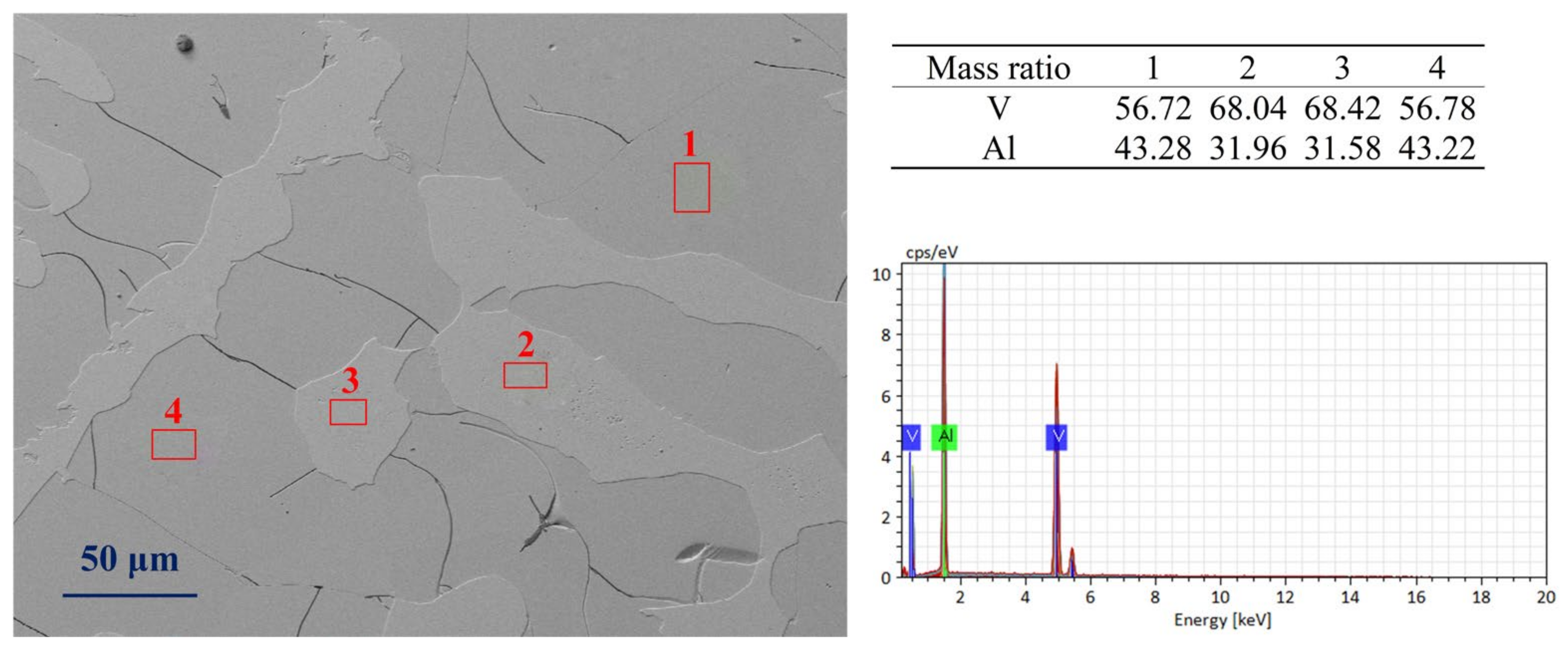
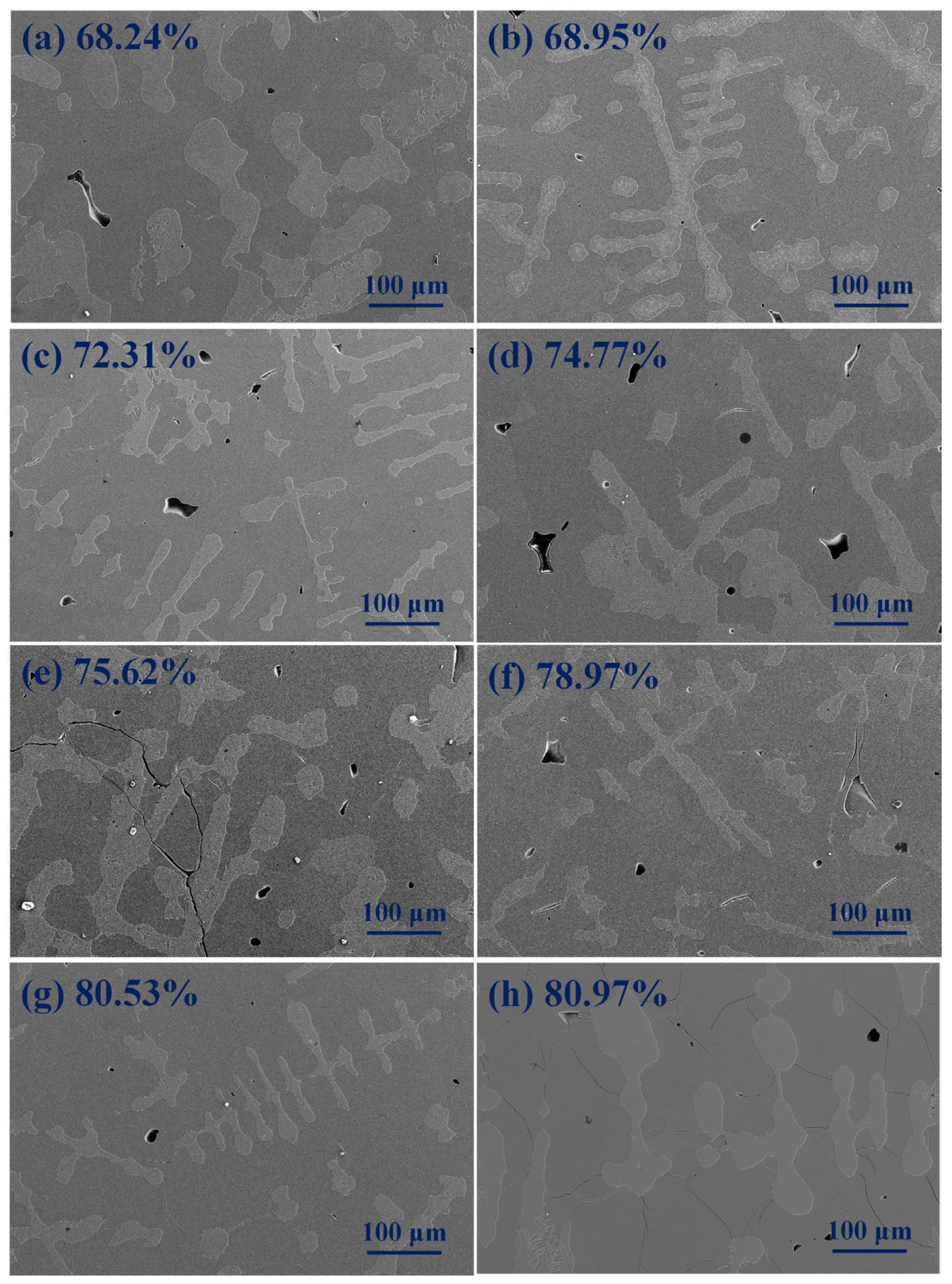
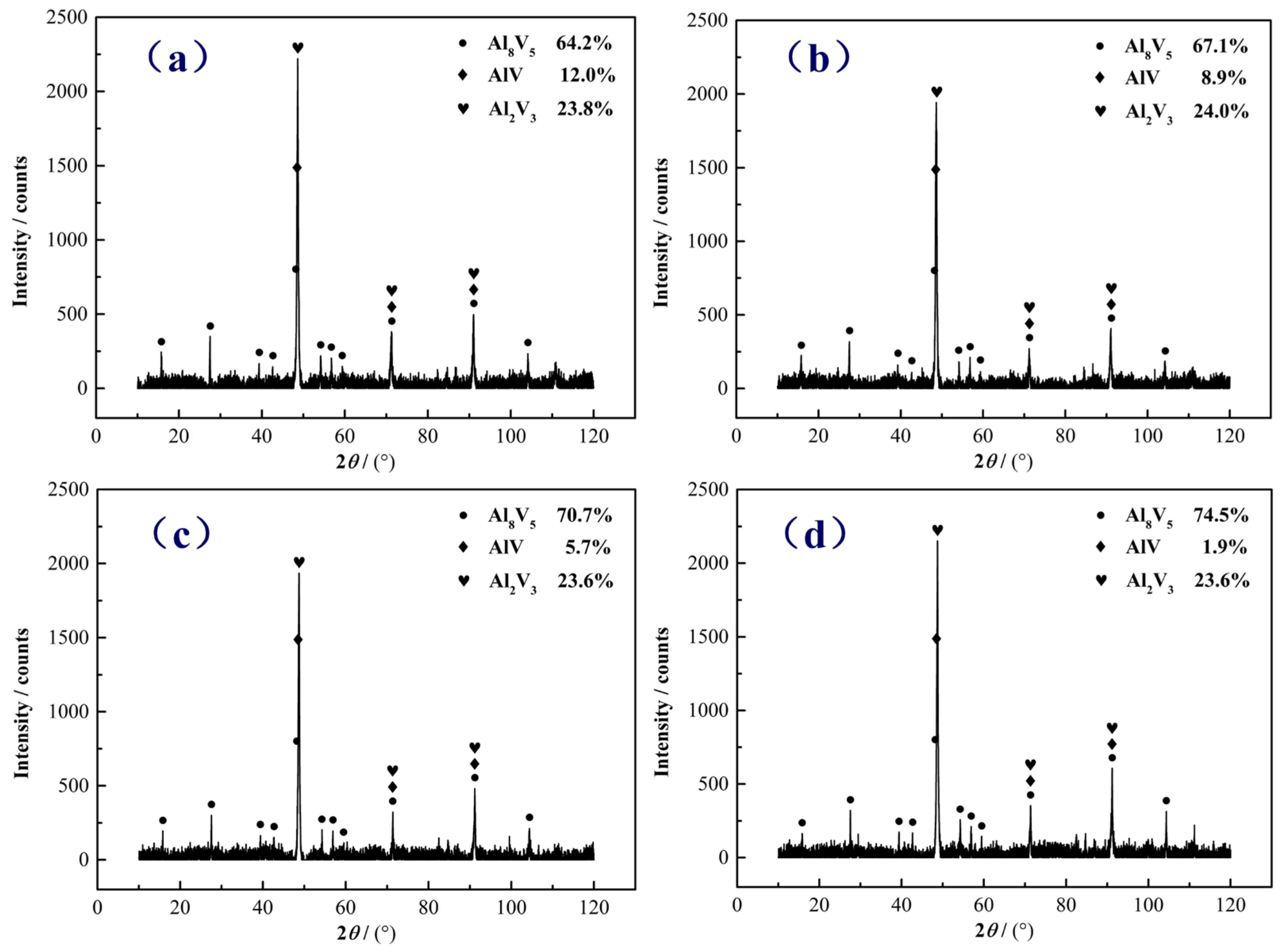

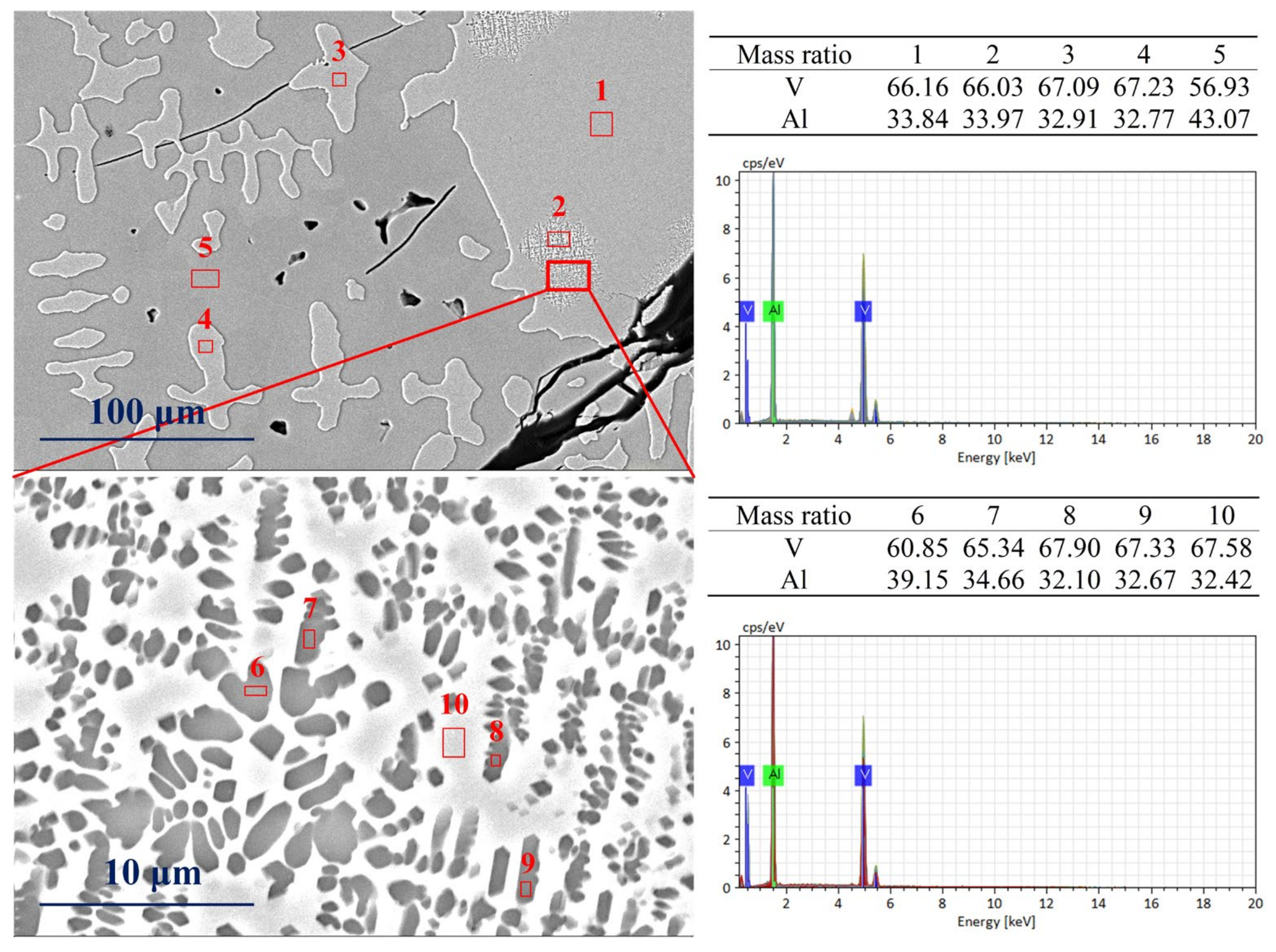
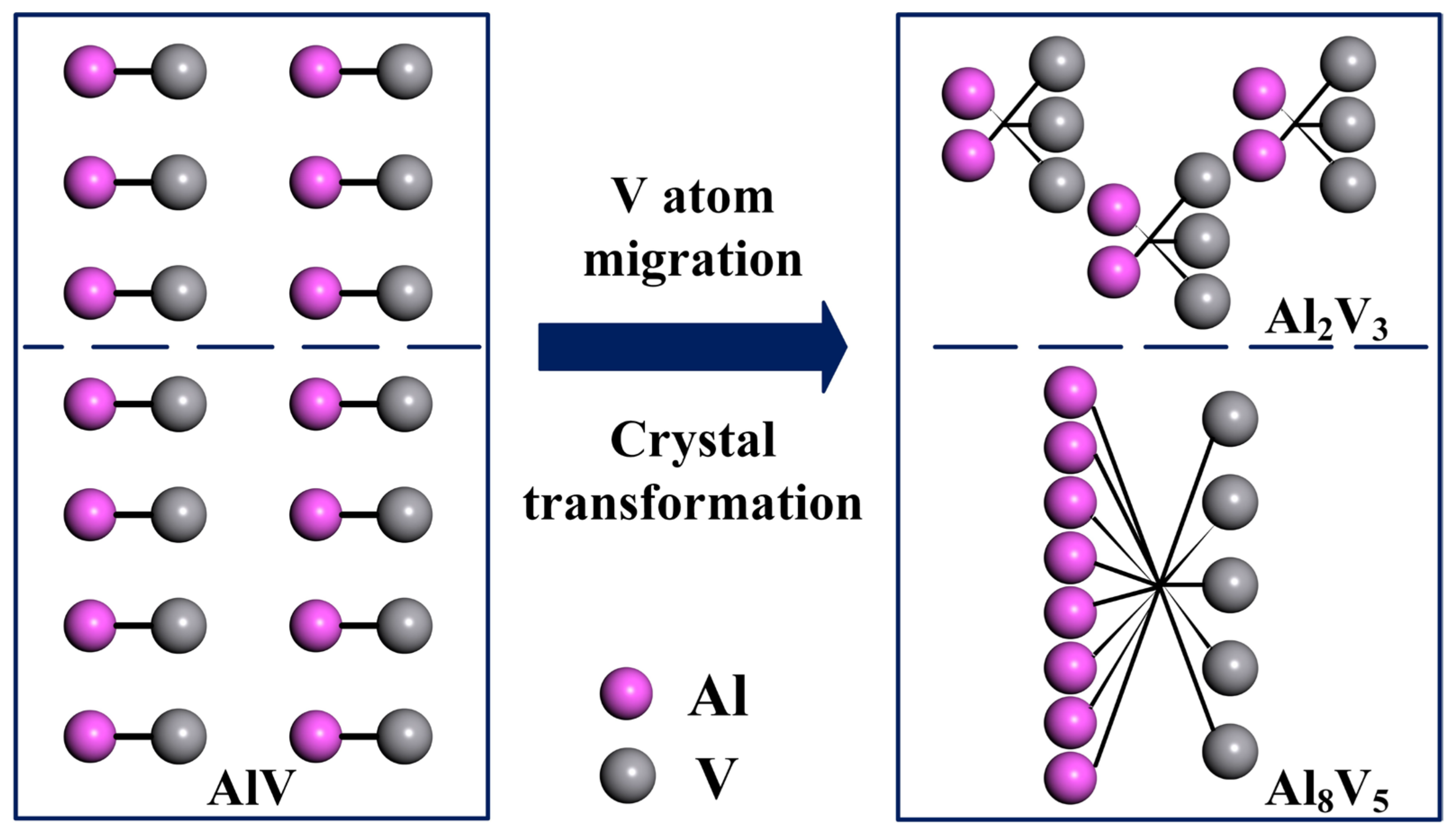
| Material | V | Al | C | N | O | Fe | Si |
|---|---|---|---|---|---|---|---|
| AlV55 | 58.290 | 41.000 | 0.025 | 0.019 | 0.028 | 0.179 | 0.114 |
| Theoretical Mass % of Al, V of AlV | Theoretical Mass % of Al, V of Al8V5 | Mass % of Al, V in AlV Phases * | Mass % of Al, V in Al8V5 Phases ** | ||||
|---|---|---|---|---|---|---|---|
| Al % | V % | Al % | V % | Al % | V % | Al % | V % |
| 34.63 | 65.37 | 45.87 | 54.13 | 31.95 | 68.05 | 43.91 | 56.09 |
Disclaimer/Publisher’s Note: The statements, opinions and data contained in all publications are solely those of the individual author(s) and contributor(s) and not of MDPI and/or the editor(s). MDPI and/or the editor(s) disclaim responsibility for any injury to people or property resulting from any ideas, methods, instructions or products referred to in the content. |
© 2024 by the authors. Licensee MDPI, Basel, Switzerland. This article is an open access article distributed under the terms and conditions of the Creative Commons Attribution (CC BY) license (https://creativecommons.org/licenses/by/4.0/).
Share and Cite
Gao, L.; Chen, H.; Yin, D.; Wang, N.; Yu, B.; Ye, M.; Wu, X.; Zhang, L.; Wu, J. Phase Transformation of AlV55 Alloy at High Temperature. Metals 2024, 14, 802. https://doi.org/10.3390/met14070802
Gao L, Chen H, Yin D, Wang N, Yu B, Ye M, Wu X, Zhang L, Wu J. Phase Transformation of AlV55 Alloy at High Temperature. Metals. 2024; 14(7):802. https://doi.org/10.3390/met14070802
Chicago/Turabian StyleGao, Leizhang, Haijun Chen, Danfeng Yin, Ning Wang, Bin Yu, Mingfeng Ye, Xiaoping Wu, Lei Zhang, and Jinshu Wu. 2024. "Phase Transformation of AlV55 Alloy at High Temperature" Metals 14, no. 7: 802. https://doi.org/10.3390/met14070802





